Wood work can significantly enhance the aesthetic appeal and functionality of a property, often leading to increased value. From custom cabinetry to hardwood flooring, quality wood installations bring warmth, character, and durability to homes. These features not only improve daily living experiences but also catch the eye of potential buyers. Sustainable wood choices align with eco-friendly trends, appealing to environmentally conscious homeowners. Whether through intricate trim work, sturdy outdoor decking, or elegant built-ins, thoughtful wood installations can transform spaces, creating a lasting impact that translates to tangible property value.
Woodwork: Enhancing Property Value and Carbon Sequestration
Wood installations in buildings offer a dual benefit: they increase property value while contributing to carbon sequestration efforts. This combination makes woodwork an attractive option for both homeowners and environmentally conscious builders.
Property Value Enhancement
- Aesthetic Appeal: Wood brings warmth and natural beauty to interiors and exteriors.
- Durability: Quality wood features can last for decades with proper maintenance.
- Functionality: Custom woodwork can provide tailored storage and living solutions.
- Market Attraction: Many buyers are drawn to homes with high-quality wood features.
Carbon Sequestration in Buildings
- Carbon Locking: Wood used in construction stores carbon for the lifetime of the building.
- 1 cubic meter of wood can store about 1 tonne of CO2.
- This carbon remains locked away as long as the wood is in use.
- Reduced Carbon Footprint:
- Wood production has a lower carbon footprint compared to steel or concrete.
- Using wood instead of more carbon-intensive materials further reduces a building’s overall emissions.
- Long-term Storage:
- Structural timber, flooring, and built-in furniture can store carbon for decades or even centuries.
- This long-term storage helps offset ongoing carbon emissions from other sources.
- Sustainable Forestry:
- When sourced from sustainably managed forests, wood use can encourage further tree planting and forest growth.
- This creates a positive cycle of carbon capture and storage.
- End-of-Life Considerations:
- Wood can often be recycled or repurposed at the end of a building’s life.
- Even when disposed of, wood breaks down more naturally than many synthetic materials.
Maximizing the Benefits
To fully leverage the value-adding and carbon-sequestering potential of woodwork:
- Choose sustainably sourced wood certified by organizations like FSC or PEFC.
- Opt for durable hardwoods in high-wear areas to ensure longevity.
- Incorporate wood into both structural and decorative elements of the building.
- Properly maintain wood features to extend their lifespan and carbon storage capacity.
- Educate potential buyers on the environmental benefits of wood-rich properties.
By thoughtfully incorporating wood into building design and construction, property owners can enjoy increased value while contributing to global carbon reduction efforts.






